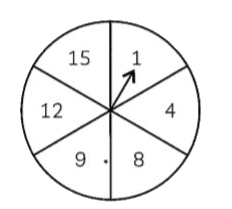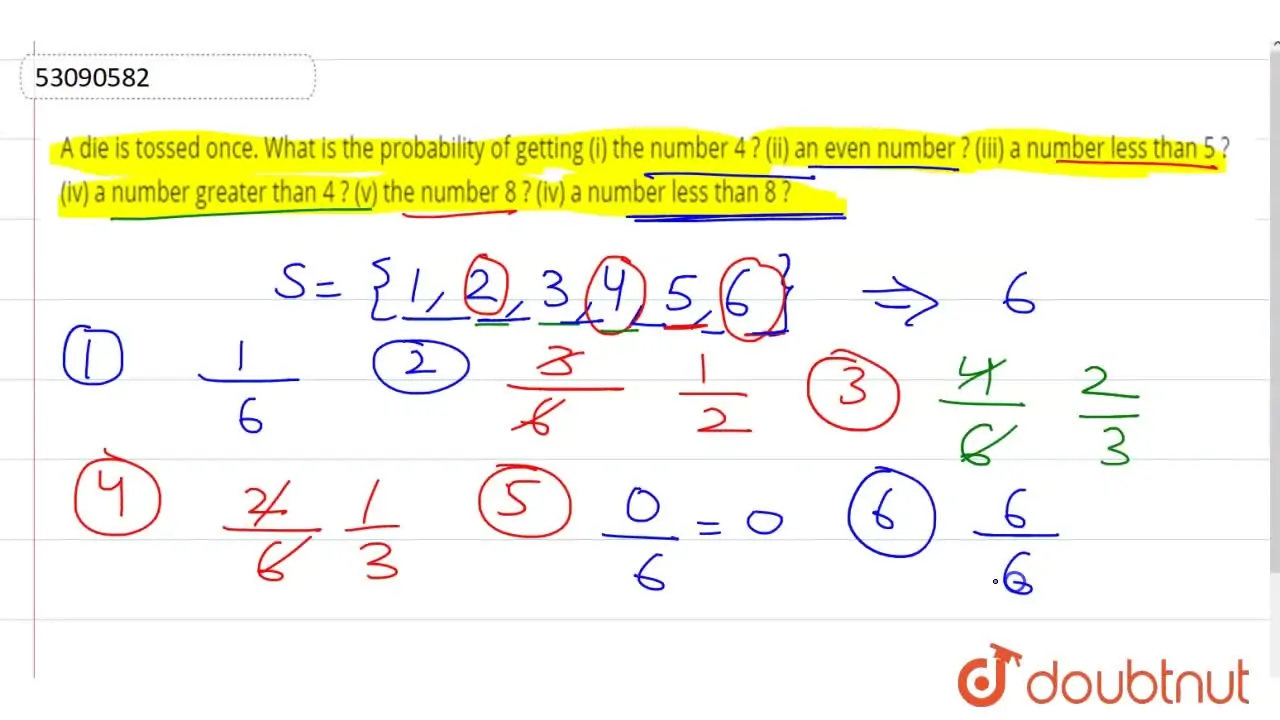A die is tossed once. What is the probability of getting
(i) the number 4 ? (ii) an even number ?
(iii) a number less than 5 ? (iv) a number greater than 4 ?
(v) the number 8 ? (iv) a number less than 8 ?
In tossing a die once, the sample space is given by
S={1,2,3,4,5,6} and, therefore, n(S) = 6.
(i) Let E1 = event of getting the number 4.
Then, E1={4} and, therefore, n(E1)=1.
∴ P(getting the number 4) =P(E1)=n(E1)n(S)=16.
(ii) Let E2 = event of getting an even number. Then,
E2={2,4,6} and, therefore, n(E2)=3.
∴ P(getting the number 4) =P(E2)=n(E2)n(S)=36=12.
(iii) Let E3 = event of getting a number less than 5. Then,
E3={1,2,3,4} and, therefore, n(E3)=4.
∴ P(getting a number less than 5) =P(E3)=n(E3)n(S)=46=23.
(iv) Let E4 = event of getting a number greater than 4. Then,
E4={5,6} and, therefore, n(E4)=2.
∴ P(getting a number greater than 4) =P(E4)=n(E4)n(S)=26=13.
(v) Let E5 = event of getting the number 8.
Since no face of the die is marked with the number 8,
we have E5=ϕ and, therefore, n(E5)=0.
∴ P(getting the number 8) =P(E5)=n(E5)n(S)=08=0.
(vi) Let E6 = event of getting a number less than 8.
Then, E6={1,2,3,4,5,6} and, therefore, n(E6)=6.
∴ P(getting a number less than 8) =P(E6)=n(E6)n(S)=66=1.
Related Playlists
- BOOK - RS AGGARWALCHAPTER - PROBABILITYEXERCISE - Exercise 31 A25videos
PROBABILITY
- BOOK - RS AGGARWALCHAPTER - PROBABILITYEXERCISE - Exercise 31 B21videos
PROBABILITY
- BOOK - RS AGGARWALCHAPTER - PROBABILITYEXERCISE - Exercise 31 B21videos
PROBABILITY
- BOOK - RS AGGARWALCHAPTER - PRINCIPLE OF MATHEMATICAL INDUCTIONEXERCISE - EXERCISE 423videos
PRINCIPLE OF MATHEMATICAL INDUCTION
- BOOK - RS AGGARWALCHAPTER - RelationsEXERCISE - EXERCISE 2E12videos
Relations
Similar Questions
die is tossed once. What is the probability of getting a number 4?
View SolutionA die is thrown once. What is the probability of getting a number greater than 4?
View SolutionA die is thrown. What is the probability of getting (i) a prime number?
(ii) a number greater than 4? (ii) a number not greater than 5?View SolutionA die is thrown once. Find the probability of getting a number more than 4.
View SolutionA die is thrown once. Find the probability of getting
(i) an even number (ii) a number less than 5
(iii) a number greater than 2 (iv) a number between 3 and 6
(v) a number other than 3 (vi) the number 5 .View SolutionA die is thrown once. Find the probability of getting a number less than 3.
View SolutionA die is trouwn once. Find the probability of getting an even number less than 5.
View SolutionA dice is rolled once. What is the probability that the number on top will be
Less than 1View SolutionA die is tossed thrice. Find the probability of getting an even number at least once
View Solution
What is the probability of getting a number less than 6 on the spinner?View Solution


